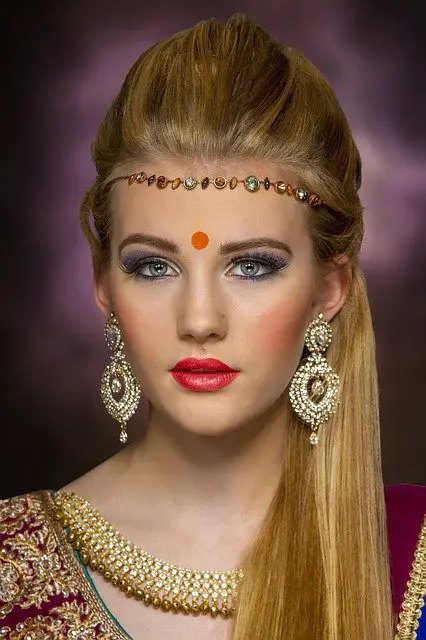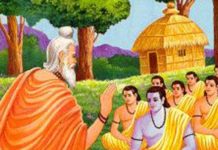What do Selena Gomez, Bollywood, and about 95% of the Indian women population have in common? Well, other than a love for song-and-dance – the Bindi!
Yes – the round red dot placed between the eyebrows, the dot that has come to represent the uniqueness of the Indian woman and her attire. The bindi may look like nothing more than ornamentation to the outside world, but as recent events have revealed, that little red dot has come to symbolize centuries of culture, religion and social identity for the Indian woman.
In the past decade, a number of western celebrities and cultural icons have found themselves facing heat over their choice to wear the bindi as body art. The likes of Vanessa Hudgens, Gwen Stefani and Selena Gomez have been seen sporting decorative motifs over their agna chakra spots at events they attended or as part of their performance costumes. Gomez has especially faced flak for sporting the bindi as an everyday fashion statement, “when the mood strikes… almost like changing a pair of earrings”, as reported in the Hindu (March 2014).
To the onlooker the “fuss” being made over a Hollywood celebrity wearing a red dot on the forehead, or a design resembling body art between the eyebrows may seem like a lot of steam spent on a trivial issue. This is what we are going to investigate in the following piece. What makes the little red dot on the forehead so sacred? Why is it that women of Southeast Asian origin get offended by people of western or European origins wearing the bindi?
In the following paragraphs, we discuss what this little (or big) red dot on the centre of the forehead means, where it all originated, its religious, cultural, and ethnic significance, and how this seemingly inconspicuous dot has thrown shade on popular youth icons over the past few years.
Origins Of Bindi (The Indian Forehead Dot)
Tracing the history of the bindi takes us back several centuries. The word ‘bindi’ is a derivative of the Sanskrit word ‘bindu’, meaning ‘a drop, or a particle’. With the development of India as a multilingual conglomeration of culture, the dot has also come to be known as ‘pottu’, ‘sindoor’ ‘kumkum’, ‘teep’, and ‘tikli’, among other things. In most cases you will see the tell-tale red dot on the forehead, between the eyebrows. This portion of the forehead between the eyebrows is said to house the ‘third eye’. Distinct from the two physical eyes, it is said to be the spiritual eye that turns inward and focuses upon God, who is believed to be within the spiritual self of every human being. It is also the seat of the agna chakra, one of the seven chakras, and the seat of spiritual wisdom. You will see this ‘inner eye’ or the ‘sixth chakra’ symbolized in a number of ancient Indian artwork.
SYMBOLISM
Wearing the bindi in this position is said to conserve energy and enhance various levels of concentration. People wear the striking dot as a religious symbol of piety, and a physical reminder to keep their thoughts positive and God-centric.
Furthermore, it is said that in ancient Aryan weddings the groom would draw a long tilaka on the forehead of his bride, usually starting from the center of the forehead and drawn up into the hairline. This was an auspicious symbol, worn with pride by the Indian woman, setting her apart from unmarried girls, elevating her status in society. This ancient practise continues even today.
The tilaka is also accompanied by the forehead dots, or bindis, which are said to usher in prosperity and symbolize a woman’s status as a woman of the house and a propagator of the progeny in her husband’s family. If the woman has the misfortune of losing her husband, the tilaka and the red bindi are no longer a part of her wardrobe. You can see the significance placed upon the tilaka or sindoor and the bindi by examining how they are portrayed in Indian films. Both the putting on, as well as the wiping away of the sindoor are deeply symbolic in the Indian culture.
Another point of significance is the red color of the red dot on the forehead. Red is supposed to symbolize purity, as well as sensuality in the Hindu tradition. That is why the red bindi was mostly worn only by married women. Younger, unmarried girls would wear black bindis. Young children, especially newborns were given a black bindi on any part of their face or body. This was said to ward away the evil eye.
COMPOSITION
In the earliest days the tilaka was an important part of the Indian apparel, along with the garland. The red dots can trace their ancestors to tiny thin leaves that were cut into various shapes and placed between the eyebrows, chin, neck, breasts, and other parts of the body. These evolved into the red dot on the forehead, made by mixing turmeric powder with the juice of limes or lemons. This would change the bright yellow color of the turmeric into the striking red hue we see on the forehead. Others used vermillion paste, or the sindoor (made of zinc oxide and dye). A fingertip was dipped into this semi-paste mixture and placed onto the spot between the eyebrows to form a perfect round bindi. There were numerous other ways in which the red dot was formed on the forehead, including vegetable dyes, various powdered mixtures, liquid kumkum, etc. Some women even used round discs dipped in the red powder or liquid to make their bindis perfect.
Colored markings between the eyebrows or on the forehead were not a gender-specific rite. A visit to the temple was marked by white, red and yellow motifs across the forehead for both men as well as women. The colors themselves have been assigned significance and could symbolize a household deity and the caste the person was born into. In fact, up until the 1970s, the dot or design on a woman’s forehead would tell you a woman’s religion, her marital status, and even her caste. They were like an identity marker on her forehead.
Modernization of Bindi

The bindi culture was revolutionized by a company called Shilpa. Their perfect red velvet dots with reusable stickers that did not leave a mark changed the way the bindi was worn. Its status as an identity marker morphed into one of every woman’s forehead dot. It no longer symbolized caste, class, or even marriage in some states. Further on in this evolution, women were able to choose how the bindi was designed. In the 1990s and 2000s, there was an explosion of demand for intricately designed, embellished bindis, though the stickable red dot never went out of fashion.
The bindi has an uncertain place on the Indian woman’s forehead today. There is a sharp line of distinction between the woman who fiercely holds on to the cultural and religious significance of the red dot on the forehead and the global Indian woman who sees it as an accessory and may or may not choose to wear it with either her western attire, or her Indian wear. We have seen a lot of these lines and boundaries being erased and re-drawn and questioned, especially over the last decade. With a growing number of Indians claiming the status of NRIs, or having cross-cultural identities, the dot on the forehead has become a symbol of either their whole identity as Indian, or a part of their cultural heritage as coming from a partially Indian background.
Stereotyping The Indian Forehead Dot
With the mixing and amalgamation of cultures that came with globalization, the Indian forehead dot became a part of the generic symbol of being Indian, just like the dusky skin, the musical accent and the bright colors that are associated with the Indian culture. It also became a part of the ‘Indian-ness export package’, joining yoga, curry, the nose ring and other such ‘exotic’ exports that seemed to reach every corner of the world through marketing and export.
Just as in other cultures, the stereotypical Indian woman was portrayed as a dusky skinned, gaudily clad, bindi-donning woman with large almond-shaped eyes, hiding behind veils. In my own experience I can think of these very stereotypes as they were portrayed in Bond movies, the Harry Potter series, and then in Slumdog Millionaire, among others.
MARGINALISATION
The Indian-ness of the bindi took on a dangerous edge in the late 1980s in New Jersey, USA, when a group called The Dot Busters publicly proclaimed that the brown skinned dot-wearers were not fit to be neighbors to the white folk. This group of men vandalized the property of those they identified as Indians, gate-crashed Indian family gatherings, and even took to assaulting and killing Indians, whom they identified, followed and accosted on the streets. This went on for quite a few years until people in the Indian community started fighting back.
EXOTICISM
After years of having second-rated minority cultures, the westerners took to exoticizing them, coloring them in hues that looked like appreciation on the outside, but still effectively objectified and marginalized Asian and African cultures, among others. This led to the feelings of fear among the children of immigrants who questioned whether it was worth the fight to hold on to culture in the face of exclusion. In her very interesting article in JUNKEE(Jan 2017),Vidya Ramachandran writes about her strong identification with her Indian Hindu culture, countered by her fear of being treated differently, or even vilified, if she were to display her pride in that culture by wearing tokens like the dot on the forehead. It seems to be universally accepted that tokens of indigenous pride like the mohawk and the red dot on the forehead are objects to be ridiculed.
Reclaiming Indegenous Culture Through The Dot On The Forehead
That face of cultural identity has drastically changed, especially over the last decade. The term ‘cultural appropriation’, or ‘cultural misappropriation’ has entered the vocabulary of cultures that have faced colonization and oppression over the past few centuries. The term was first used in the 1980s in the context of criticizing the cultural, societal and geographical colonization by the British and other European countries who exploited other lands and people for their own economic benefit. The term has emerged in recent literature once again to criticize the use of religious or cultural symbols that originated among a minority group by people that belonged to a dominant group. This can be seen in the misappropriation of the Native Indian mohawk, their traditional headdress, the costumes and makeup of the Japanese geisha, and of course the Indian forehead dot – the bindi.
This has been most clearly seen on the runway in major fashion shows where these cultural symbols were freely used out of the context they originated in, sparking heated debate about whether expression through art allowed for a person from a dominant culture to extract these icons and symbols from a suppressed or minority culture and use it for their own means. It was obvious that there was a lot of emotion entwined into these cultural symbols. For many of these people, the extraction and abuse of these symbols of their culture and religion was colonization and exploitation all over again. While those that engaged in the act tried to label it as an act of respect and appreciation of these cultures, the indigenous people proclaimed that a very firm line needed to be drawn between the appreciation and appropriation of these symbols.
Returning to Ramchandran’s article, she states that the question of cultural appropriation in terms of the bindi becomes a little questionable, since within the indigenous culture itself there are various meanings associated with the bindi, and varying levels of importance assigned to it. The Indian forehead dot can be seen to be variously used in the different regional states of India. While it could symbolize deep religious roots for one, it may be an unquestionable symbol of marriage and sexual power in another, while in many other states women wear the forehead design or dot as a general symbol of the woman’s femininity.
A number of articles have been written on this subject over the past decade, particularly the use of the bindi as nothing more than a forehead tattoo or ornament by Hollywood celebrities. Most notably we have seen the likes of Gwen Stefani and Selena Gomez being joined by Natalie Portman, Madonna, and Ashley Judd sporting the bindi and throwing the Indian forehead dot into the realm of a famously fashionable trend. Writers and thinkers from the Indian diaspora took to their tablets and laptops to express their horror at white girls showing off their dotted foreheads at such unlikely events as the Coachella Music Festival.
Context was what made up the entire question. The gori wearing a bindi was not appreciated, especially when she wore it as a merely decorative piece. It even led to a movement called #Reclaimthebindi by an anonymous woman who put together an online movement that called for a recognition of the cultural and religious significance of the forehead dot. The bindi just serves as a starting point here, both literally as well as figuratively.
So where does this leave us? Is it wrong for white folk to wear bindis? Nadya Agrawal’s article in the online magazine Kajal throws the debate wide open as she states that the question is not one that asks who can wear the bindi, but one of “who decides who can wear it”. She sweeps matters of liberty and justice into answering her own question, stating that South Asian women cannot be accused of infringing upon the liberty of westerners to wear the traditional dot on forehead since that sort of liberty infringes upon the religious and cultural identity of the Indian woman. The reclaiming of the bindi is a reclamation of justice that has been denied them over centuries of oppression and cultural negation.
CONCLUSION
At the end of it all the red dot on forehead continues to be a subject of mysticism, and therefore, fascination to a lot of other cultures. It has become a symbol of the Southeast Asian woman, and, recently, something of a point of contention our women are making with those they hold responsible for demeaning our non-European psyche.
In the end, the Indian forehead dot has evolved from a culturally and religiously significant dot, to a tool that our women, and our culture as a whole, have been able to use to bring themselves on equal footing with those who were once a dominating culture.
Ref:-
● https://wou.edu/wp/exhibits/files/2015/07/hinduism.pdf
● http://www.fashionencyclopedia.com
● https://globalflows2014.wordpress.com
● https://www.thecut.com
● https://reclaimthebindi.tumblr.com/
● https://en.wikipedia.org
● https://www.ancient-origins.net
● https://www.hinduamerican.org/
● https://nileswestnews.org/
● https://junkee.com/
● https://www.learnreligions.com/



